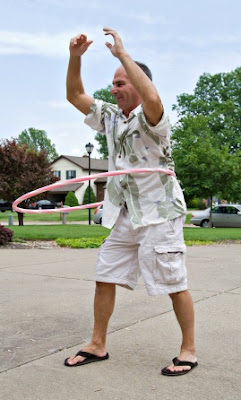If you’ve read my posts from a few weeks ago, you know that I keep mentioning kettlebells. There’s a reason for that, of course: I love the things.
I’m writing this post because I want to mention an alternative to the standard gym grind. I keep meeting folks who have never seen a kettlebell, much less used one, and I’ve gotten too much good out of mine not to praise it.
But before I wax rhapsodic about the virtues of kettlebell training, I should lay out some basic info:
- A kettlebell is essentially a cannonball with a handle. They come in a wide range of weights: 18 lbs. is the starting weight for an average woman and 35 lbs. is for an average man. Because of its shape, a kettlebell’s center of mass moves relative to your hand as you swing it, and this makes it very different from using a barbell.
- Kettlebells are not new, despite the latest Jillian Michaels fad. They got their start during the 18th century in Russia, where the kettlebell is called a girya. They were so influential that the Russian word for “strongman” is girevik: “Kettlebeller”.
- Kettlebell training is not really a beginner’s exercise. It involves coordination, ballistic swinging motions, and overhead elevation of significant weight. While not necessarily dangerous, it is certainly riskier than the Stairmaster™.
I started swinging ‘bells because I was never a great fan of weightlifting. I gain muscle slowly, and the grind of the gym was terribly unappealing, although I tried it for years on and off. Three years ago I recognized my deteriorating physical condition and decided to buy a kettlebell. It seemed interesting if nothing else.
 |
| Swings |
When I finally got it and tried it, I was floored at the intensity of the work and the coordination it required. My heart pounded after just a minute of swings. My legs shook after two minutes. This relatively light ball of iron forced me to attend to a whole host of physical relationships that I had ignored for years. I had to coordinate everything just to swing it back and forth! It felt athletic in a way barbells never had.
I started out using it twice a week, then bumped it up to three. I started walking straighter as my hamstrings and adductors (inner-thigh muscles) became strong enough to balance out my quadriceps. My grip strength improved vastly—I was quite unkind to a smug missionary who made the mistake of offering me his hand, a fact of which I am not proud. Sort of.
I lost fat. Turns out that swinging 35 lbs. forward and backward burns a lot of calories per minute—far more than more traditional cardiovascular exercise like jogging. The more advanced kettlebell swing, called the snatch, is so intense that it’s used as a gauge of overall fitness by the U.S. Secret Service: 200 snatches in 10 minutes with a 53 lb. kettlebell gets you high marks.
Most strangely, my general athletic ability improved. I have never been a strong swimmer, but last summer my wife and I took an impromptu swim across Green Lake here in Seattle, which is about ¼ mile of open water. That is (conservatively) three times as far as I have ever swum in my life. In the kettlebell community, this sort of global improvement is often referred to as the “What the hell?” effect. Enthusiasts blame it on the whole-body nature of the movements involved in all exercises using a ‘bell.
I should tell you that my affair with the girya has not been without its challenges. I have congenital shoulder problems that have required me to modify some of the exercises to prevent tendon pinching. Excessive kettlebell training has sometimes required a trip or two to the chiropractor—after all, weight must be transmitted through the spine. That said, my experience has been overwhelmingly positive.
Enough about how awesome they are. If you’re interested in learning to swing ‘bells, you have a lot of resources. If you play well with others, Crossfit centers are usually very serious about their kettlebell work and teach it correctly. If you prefer to fly solo, YouTube is a great source for “how-to” technique videos once you have a girya of your own. Pavel Tsatsouline has made a career out of kettlebells, and has a number of books and videos of varying quality available through his “Russian Kettlebell Challenge” company. Beware: his marketing approach can be rather… enthusiastic.
And while kettlebells are popular enough that sports stores often carry them, I can’t recommend any that I’ve seen. Most of those ‘bells are made with a handle that is too wide; it works great for two-handed swings, but it just gets in the way with most other exercises. I’ve bought five from DragonDoor.com and I’ve been happy with them all; websites selling very similar ‘bells abound.
Have you had an experience with kettlebells? Have you never tried them? Is this the first you’ve ever heard of them? Let us know by leaving a comment!









